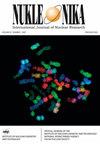放射分散装置(RDD)情景下肺癌风险的成本效益方法
IF 0.3
4区 物理与天体物理
Q4 CHEMISTRY, INORGANIC & NUCLEAR
引用次数: 3
摘要
放射性物质释放到环境中会导致人群暴露在危险环境中,并导致癌症发病率增加等严重的健康问题。在这种情况下,能够从情景中提供有用的基本信息的实用方法对于立即作出决定和未来的风险评估是有价值的。在这项工作中,考虑了一个充满镅-241的放射性扩散装置(RDD)的模拟。热点代码模拟的辐射剂量被用作BEIR V流行病学方程的输入,产生用于评估肺癌发展风险的数据。该方法可用于为应急人员提供培训,目的是在RDD情景的早期阶段为应急决策提供初步支持。模拟结果可用于估计(a)可能受影响人口的规模,(b)考虑到个人性别和地点的保护行动类型,(c)吸收剂量,(d) 5年期间肺癌发病率预测矩阵,以及(e)初始决策环境中的成本效益。本文章由计算机程序翻译,如有差异,请以英文原文为准。
Cost-effective approach to lung cancer risk for a radiological dispersal device (RDD) scenario
Abstract A release of radioactive material into the environment can lead to hazardous exposure of the population and serious future concerns about health issues such as an increased incidence of cancer. In this context, a practical methodology capable of providing useful basic information from the scenario can be valuable for immediate decisions and future risk assessment. For this work, the simulation of a radiological dispersal device (RDD) filled with americium-241 was considered. The radiation dose simulated by the HotSpot code was used as an input to the epidemiological equations from BEIR V producing the data used to assess the risk of lung cancer development. The methodology could be useful in providing training for responders aimed to the initial support addressed to decision-making for emergency response at the early phase of an RDD scenario. The results from the simulation allow estimating (a) the size of the potentially affected population, (b) the type of protection action considering gender and location of the individuals, (c) the absorbed doses, (d) the matrix of lung cancer incidence predictions over a period of 5 years, and (e) the cost-effectiveness in the initial decision environment.
求助全文
通过发布文献求助,成功后即可免费获取论文全文。
去求助
来源期刊

Nukleonika
物理-无机化学与核化学
CiteScore
2.00
自引率
0.00%
发文量
5
审稿时长
4-8 weeks
期刊介绍:
"Nukleonika" is an international peer-reviewed, scientific journal publishing original top quality papers on fundamental, experimental, applied and theoretical aspects of nuclear sciences.
The fields of research include:
radiochemistry, radiation measurements, application of radionuclides in various branches of science and technology, chemistry of f-block elements, radiation chemistry, radiation physics, activation analysis, nuclear medicine, radiobiology, radiation safety, nuclear industrial electronics, environmental protection, radioactive wastes, nuclear technologies in material and process engineering, radioisotope diagnostic methods of engineering objects, nuclear physics, nuclear reactors and nuclear power, reactor physics, nuclear safety, fuel cycle, reactor calculations, nuclear chemical engineering, nuclear fusion, plasma physics etc.
 求助内容:
求助内容: 应助结果提醒方式:
应助结果提醒方式:


